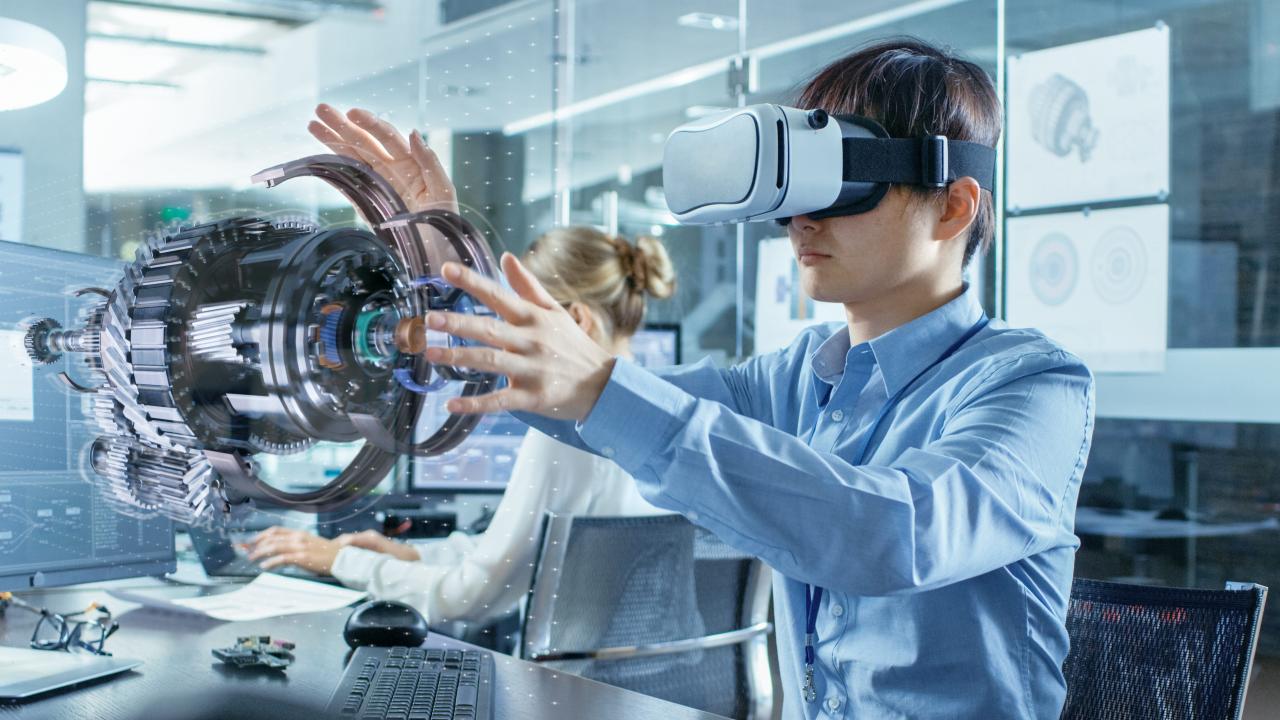The digital frontier is rapidly expanding beyond the flat, two-dimensional screens of our computers and smartphones. A new paradigm shift, powered by immersive technologies, is underway, creating rich, interactive, and spatially aware digital experiences. At the heart of this revolution are the architects of these new realities: Immersive VR/AR Developers. These are not just coders; they are world-builders, interaction designers, and technical artists who are blurring the lines between the physical and digital worlds. The demand for skilled developers in Virtual Reality (VR), Augmented Reality (AR), and the broader spectrum of Extended Reality (XR) has never been higher, driven by the nascent metaverse, enterprise adoption, and a new wave of consumer hardware.
This comprehensive guide is designed to be your ultimate roadmap. We will delve deep into the core concepts of immersive technologies, explore the day-to-day responsibilities of a developer in this field, outline the essential skills you must cultivate, and provide a step-by-step plan to launch your career. Whether you are a student, a developer from another field looking to transition, or simply a tech enthusiast curious about the future, this article will equip you with the knowledge needed to embark on this exciting journey. We will cover everything from the fundamental differences between VR and AR to building a portfolio that will make you stand out to employers.
Understanding the Immersive Technology Spectrum
Before diving into the “how,” it’s crucial to understand the “what.” The terms VR, AR, MR, and XR are often used interchangeably, but they represent distinct concepts on an immersion spectrum. For a developer, knowing these differences is fundamental as they dictate the design principles, hardware targets, and application use cases.
-
A. Virtual Reality (VR): The Digital Escape Virtual Reality is the most well-known immersive technology. Its primary goal is to achieve full immersion by completely replacing a user’s real-world environment with a computer-generated one. When a user puts on a VR headset, like a Meta Quest 3 or a Valve Index, their senses of sight and hearing are taken over by the virtual world. The goal is to create a sense of “presence”—the feeling of actually being in that digital space. For developers, this means the entire world must be built from scratch, from the skybox to the smallest interactive object. The primary challenge and opportunity in VR development is creating believable, comfortable, and engaging worlds that users want to spend time in, whether for gaming, social interaction, training simulations, or therapeutic experiences.
-
B. Augmented Reality (AR): The Digital Overlay Augmented Reality does not seek to replace the real world but to enhance it. AR applications use the camera on a device, typically a smartphone or specialized glasses, to superimpose digital information—such as images, text, and 3D models—onto the user’s view of their physical surroundings. The iconic game Pokémon GO is a perfect example of mainstream AR. Other practical applications include AR navigation that shows directional arrows on the actual street, or retail apps that let you see how a virtual piece of furniture would look in your living room. For developers, AR presents unique challenges like real-world surface detection (plane finding), light estimation (to make virtual objects look like they belong), and marker or markerless tracking. The focus is on creating seamless and contextually relevant interactions that add value to the user’s real-world tasks and environment.
-
C. Mixed Reality (MR): The Interactive Overlay Mixed Reality, often considered an advanced form of AR, takes the concept of digital overlays a step further. In an MR experience, virtual objects are not just superimposed on the real world; they are spatially aware and interactive. This means a virtual object can be “placed” on a real table and will stay there as the user walks around it. The user can interact with this virtual object using their hands, much like they would with a physical object. Devices like the Microsoft HoloLens 2 are pioneers in this space. MR bridges the gap between the physical and digital, allowing for complex, hands-on interactions. Developers working in MR are focused on creating sophisticated applications for fields like remote assistance, complex data visualization, and advanced surgical or engineering training where digital information needs to coexist and interact with the physical workspace.
-
D. Extended Reality (XR): The All-Encompassing Umbrella Extended Reality (XR) is the umbrella term that encompasses VR, AR, and MR. It represents the entire spectrum from complete immersion in a virtual world to interactive digital overlays in the real world. As the technologies converge and hardware becomes more capable of switching between these states, “XR Developer” is becoming a more accurate and future-proof title for professionals in this field. An XR developer possesses a versatile skill set that allows them to build experiences for any point on this immersive continuum.
The Core Responsibilities of an Immersive VR/AR Developer
What does a VR/AR developer do all day? While writing code is a significant part of the job, the role is multifaceted and often involves a blend of creative and technical tasks.
-
A. Conceptualization and Prototyping: The journey often begins with an idea. A developer needs to work with designers and stakeholders to brainstorm and prototype the core mechanics of an experience. This involves creating rapid, low-fidelity prototypes to test assumptions about user interaction, comfort, and engagement before committing to full-scale development.
-
B. 3D Environment and Asset Integration: Unlike 2D development, immersive experiences are built in 3D space. Developers are responsible for building or integrating 3D environments, models, textures, and animations created by 3D artists. They must ensure these assets are optimized to run efficiently on the target hardware.
-
C. Core Interaction and Logic Programming: This is the heart of the development process. Using programming languages like C# (for Unity) or C++ (for Unreal Engine), developers write the scripts that govern everything: how a user moves, how they interact with objects, the physics of the world, the rules of a game, or the functionality of a training module.
-
D. Designing UI/UX for Spatial Computing: User Interface (UI) and User Experience (UX) design in XR is fundamentally different from web or mobile. Menus can’t just be slapped on the screen; they must exist within the 3D space. Developers must consider factors like user comfort (avoiding motion sickness), intuitive interaction models (hand tracking, controller input), and how to present information without overwhelming the user. This is a specialized and critical skill.
-
E. Performance Optimization: This is arguably one of the most crucial responsibilities. For a VR experience to be comfortable, it must maintain a high and stable frame rate (typically 90 frames per second or higher). Dropped frames can instantly cause disorientation and motion sickness. Developers must constantly profile their applications, optimizing everything from 3D models (polygon count) and textures to code and shaders (draw calls) to ensure a smooth, performant experience.
-
F. Cross-Platform Deployment: The XR market is fragmented with various headsets and platforms (Meta Quest, PC VR, PlayStation VR, ARKit for iOS, ARCore for Android). A developer is often tasked with building an application that can be deployed across multiple platforms, which requires a deep understanding of each platform’s specific Software Development Kit (SDK) and hardware limitations.
The Essential Skillset for VR/AR Development

To succeed as an immersive developer, you need to cultivate a unique blend of technical and creative skills. This is a demanding field that requires continuous learning.
-
A. Proficiency in a Major Game Engine Game engines provide the foundational framework for creating real-time 3D experiences. Mastering one is non-negotiable.
- Unity: The most popular choice for indie and mobile XR development. It uses the C# programming language, has a gentler learning curve, and boasts a massive Asset Store filled with pre-made tools and art. Its cross-platform support is excellent, making it a versatile choice.
- Unreal Engine: Known for its cutting-edge graphical fidelity and visual scripting system called Blueprints (which allows for coding without writing code). It uses the C++ language for more complex logic. Unreal Engine is often the choice for high-end, visually stunning experiences and AAA games.
-
B. Strong Programming Fundamentals While visual scripting has its place, a deep understanding of programming is essential for professional development.
- C# (C-Sharp): This is the language of Unity. If you choose the Unity path, mastering C# is your top priority. You’ll need a solid grasp of object-oriented programming (OOP) principles.
- C++: This is the language of Unreal Engine. It’s a more complex and powerful language that offers finer control over memory and performance, which is critical for high-end applications.
-
C. Understanding of 3D Graphics and Mathematics You don’t need to be a math genius, but a solid grasp of key mathematical concepts that underpin 3D graphics is vital. This includes:
- Linear Algebra: Understanding vectors (for position and direction), matrices (for transformations like scaling, rotation, and translation), and dot/cross products is fundamental.
- Quaternions: These are a mathematical tool used to represent rotations in 3D space without the problems that can arise from other methods (like gimbal lock). Game engines handle most of the complexity, but understanding what they are is crucial for debugging rotation issues.
-
D. Familiarity with XR SDKs and Hardware You need to understand the tools and limitations of the hardware you are developing for. This means getting familiar with the SDKs provided by platform holders:
- Meta Quest SDK (Oculus Integration): For developing for the popular Quest line of standalone headsets.
- OpenXR: An open, royalty-free standard that aims to provide universal access to VR and AR devices, making cross-platform development easier.
- ARKit (Apple) & ARCore (Google): The respective frameworks for building AR experiences on iOS and Android devices.
-
E. Basic Knowledge of 3D Modeling and Animation While you’ll likely work with dedicated 3D artists, you need to understand their workflow. Having basic skills in software like Blender (free and open-source), Maya, or 3ds Max allows you to create simple prototype assets, modify existing ones, and communicate more effectively with the art team.
-
F. Specialized UI/UX Design for Immersive Experiences As mentioned, this is a unique discipline. You must study the principles of immersive interaction design. This includes understanding diegetic UI (interfaces that exist within the game world, like a wrist-mounted display) versus non-diegetic UI (traditional 2D overlays). You must prioritize user comfort and accessibility at all times.
-
G. Version Control Systems In any professional software development environment, you will be required to use a version control system. Git is the industry standard. Learning how to use Git and platforms like GitHub or GitLab to manage your code, collaborate with a team, and track changes is an absolute necessity.
Your Step-by-Step Roadmap to Becoming a VR/AR Developer

Here is an actionable plan to guide your journey from novice to hirable developer.
- Step 1: Build a Strong Foundation in Programming: Before you even open a game engine, make sure you have solid programming fundamentals. Pick either C# or C++ and learn its core concepts thoroughly through online courses, books, and practice exercises.
- Step 2: Master a Core Game Engine: Choose either Unity or Unreal Engine and dive deep. Follow their official learning pathways, watch tutorials from trusted creators, and deconstruct existing projects to see how they work.
- Step 3: Acquire and Use an XR Device: You cannot effectively develop for a platform you don’t use. Purchase a consumer-grade VR headset (a Meta Quest is an excellent, accessible starting point). For AR, your modern smartphone is sufficient to begin learning with ARKit or ARCore.
- Step 4: Start with Small, Guided Projects: Your first project shouldn’t be a massive open-world game. Start small. Build a simple object interaction system, create a basic AR business card, or develop a VR archery game. Completing small projects builds confidence and skills incrementally.
- Step 5: Develop Your “Hero” Portfolio Project: Once you have a few small projects under your belt, it’s time to create a more substantial, original project. This “hero” project should be your main showcase piece. Document its development process through a blog or video devlog. This demonstrates not just your final skill but also your problem-solving process.
- Step 6: Network and Engage with the Community: Join XR developer communities on Discord, Reddit, and LinkedIn. Share your progress, ask for feedback, and help others when you can. Attend virtual or local meetups. Networking is a powerful tool for learning and finding job opportunities.
The Future is Immersive: Career Outlook
The field of immersive technology is not a fleeting trend; it is the next evolution of computing. The career outlook for skilled VR/AR developers is incredibly bright. Growth is being fueled by several key areas:
- The Metaverse: While the term is hyped, the underlying concept of persistent, interconnected virtual worlds will require a massive workforce of developers to build it.
- Enterprise Adoption: Industries are increasingly using XR for tangible ROI. This includes surgical training in healthcare, remote assistance for field technicians in manufacturing, architectural visualization in real estate, and collaborative design in engineering.
- Advancements in AI: The integration of Artificial Intelligence will lead to more dynamic and intelligent XR experiences, from hyper-realistic NPCs to AI-driven generative environments.
As technology progresses with lighter, more powerful headsets and advanced haptic feedback systems, the demand for developers who can harness this technology will only intensify. This is a field where you are not just writing code—you are building the future of human-computer interaction. Your journey starts now.














